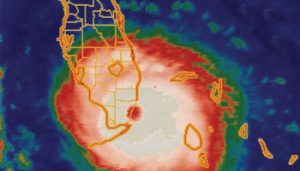Its that time of year again. Hurricane Season, and with it comes lots of wind and rain. Sometimes too much wind and rain. It is important to be prepared for whatever mother nature throws your way. Especially when you have citrus groves.
Hurricane Season begins on June 1st and lasts through November 30th. Any hurricane or severe tropical storm poses a great threat on citrus groves. Tree damage can occur from strong winds, and grove flooding happens when there is too much rain. With proper and timely preparation, citrus growers can minimize the damage and losses.
Plan and Prepare
 The best way to prepare for a hurricane is to devise a plan and use it far before June. Although hurricane season starts in June, they are most likely to occur in August and September. This is toward the end of the season when the soil and water retention areas are least able to accommodate more water. A good hurricane plan provides both protection from the storm and recovery afterwards. Strong winds causing tree damage cannot be controlled, but growers can take steps to protect the people, equipment and supplies that will be needed in the recovery process.
The best way to prepare for a hurricane is to devise a plan and use it far before June. Although hurricane season starts in June, they are most likely to occur in August and September. This is toward the end of the season when the soil and water retention areas are least able to accommodate more water. A good hurricane plan provides both protection from the storm and recovery afterwards. Strong winds causing tree damage cannot be controlled, but growers can take steps to protect the people, equipment and supplies that will be needed in the recovery process.
Before the Storm
- Personnel Assignments: Making a list of all tasks that will need to be done will prevent last-minute and unanticipated issues. Make sure each team member knows their responsibilities and duties. Also, make sure to have a contact list with names and numbers ready at all times.
- Safety Training: Training all team members in safe operation of unfamiliar equipment is important.
- Liquid Tanks: Keeping all tanks containing fuel, fertilizer, and other necessary materials, full so they do not move in the wind and rain, and to ensure that those materials are available when needed.
- Cultural Practices: Trees should be pruned regularly to reduce broken limbs and minimize toppled or uprooted trees. Windbreaks can also reduce tree damage and the spread of citrus canker bacterium.
- Emergency Equipment: Make sure that all emergency equipment is on hand and in good working condition.
- Communications Equipment: Have hand-held portable radios with extra charged battery packs and ensure that radios are in good working order.
- Hazardous Materials: Hazardous materials should be secured prior to a storm, and gasoline pumps should be shut down.
- Emergency Contacts: Keep a list of important phone numbers, especially electric companies, local emergency operations, sheriff and medical facilities.
Post-Storm Recovery
 Activity Check List: An activity check list will help ensure that all essential damage assessment and recovery operations are carried out.
Activity Check List: An activity check list will help ensure that all essential damage assessment and recovery operations are carried out.- Employee Call-In: Maintain a current list of employee locations and phone numbers.
- Damage Inspection: Safely survey lands and assess tree and property damage.
- Clear Road Access: Clearing the roads of debris is important so that workers have a clear path, which will aid in a quicker recovery effort.
- Water Removal: Within 72 hours after, remove excess water from tree root zones to avoid feeder root damage.
- Tree Rehabilitation: Reset any fallen trees to an upright position. This must be done properly. Toppled trees must been pruned back to sound wood. Painting exposed trunks and branches with white latex paint helps prevent sunburn.
Tropical Depressions, Tropical Storms, and Hurricanes
Florida experiences a lot of “tropical cyclones”, this term includes tropical depressions, tropical storms, and hurricanes. The difference between each of these is determined by the wind strength.
 Tropical Depression: Sustained winds are less than 39 mph. Wind damage to trees begins at 40 degrees.
Tropical Depression: Sustained winds are less than 39 mph. Wind damage to trees begins at 40 degrees.- Tropical Storms: Sustained winds between 39 and 73 mph. At these speeds, light damage to groves will occur.
- Hurricanes: Sustained winds are greater than 73 mph and are further categorized from 1 through 5. For categories 1 and 2, moderate damage to groves will occur. The first 5 rows of trees to windward may have snapped or broken, or blown over. Categories 3 and 4, considerable damage to groves occur. The first 10 rows of trees may be snapped or uprooted. For category 5, catastrophic damages to groves will occur.
- Wind Gusts and Tornados: Wind gusts greatly increase the potential damage because gusts are generally 30% stronger than sustained winds.
- Rainfall: Fast moving storms will not drop as much rain as slow moving storms. Tropical depressions bring more rain because they move slower than tropical storms and hurricanes.
If you have would like more information about hurricane preparedness for citrus groves, please contact your local extension office.
 0
0
 Activity Check List: An activity check list will help ensure that all essential damage assessment and
Activity Check List: An activity check list will help ensure that all essential damage assessment and  Tropical Depression: Sustained winds are less than 39 mph. Wind damage to trees begins at 40 degrees.
Tropical Depression: Sustained winds are less than 39 mph. Wind damage to trees begins at 40 degrees.